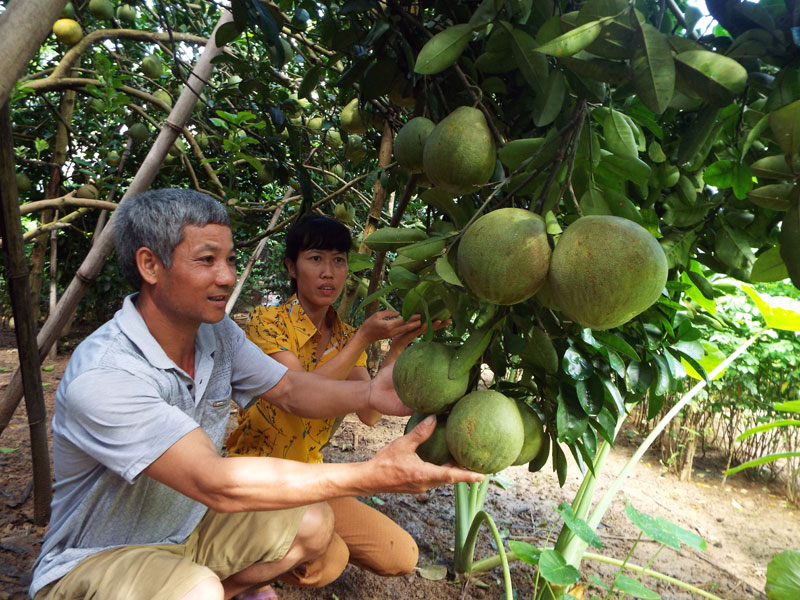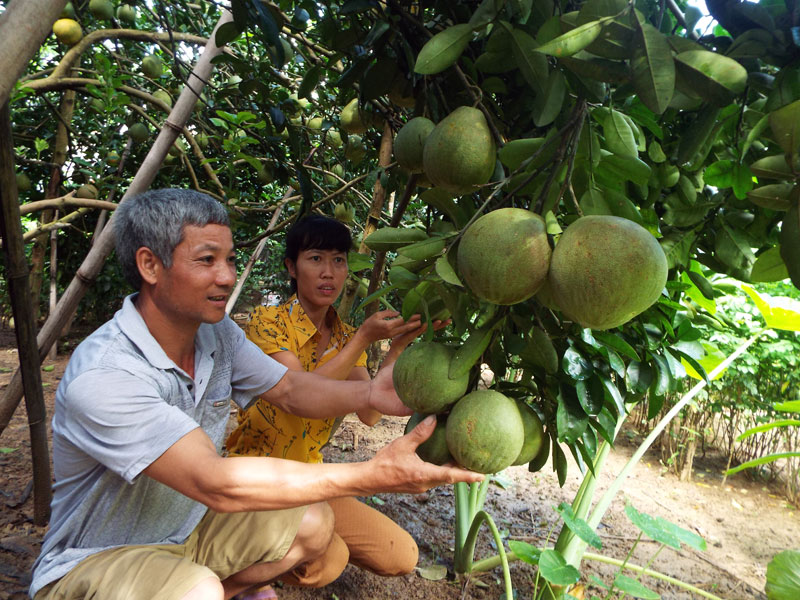
(HBO) – We returned to Dong Lai, one of the communes which specialise in growing pomelos. Head of Dong Tien hamlet Le Duc Canh, who took us on a tour around pomelo growing households, said local residents are enjoying a bumper pomelo crop this year.

Vu Van Bay’s family in Dong
Tien hamlet, Dong Lai commune, Tan Lac district, plant nearly one hectare of
pomelos with about 250 trees. Of which 90 trees are yield fruits this crop.
Thanks to farmers’ improved cultivation
techniques, the pomelo productivity has been raised significantly, from about
200 fruits in the previous crops to 400-500 per tree in this crop. Many farmers
like Tran Cong Dam and Luong Ba Cuong even harvested 500-600 fruits from each
pomelo tree.
In the previous crop, each pomelo fruit was sold for from 25,000-30,000 VND. If
the price averages 20,000 VND, farmers can earn about 4 million VND from 200
fruits, and nearly 10 million VND per tree each year. Therefore, tens of pomelo
trees can help farmers pocket hundreds of millions of VND. Local farmers are
now planting pomelos in their orchards, hills and fields.
All 67 households in Dong Tien hamlet have grown rosy-pulped pomelos. They have
turned their gardens into pomelo orchards. About 16 out of
20 hectares of pomelos
in the hamlet are ready for harvest. Many farmers have leased land and joined
hands with their peers in other communes to grow pomelos.
With favourable soil and weather conditions, Dong Lai is seen as the home land
of pomelos. Traders have come to order pomelos of this crop with prices equal
to last year’s. Local farmers are expected to get higher earnings.
Some
68 hectaresout of
168 hectaresof pomelos in Dong Lai commune are in the harvest period. Households growing
pomelos have savings. Many with more than one hectares of pemelos can earn hundreds of millions of VND each year.
Head of Tan Lac district’s Agriculture and Rural Development Division Vu Quang
Hung said Resolution No. 10-NQ/HU of the district’s Party Committee on rosy-pulped
and green skin pomelo development during the 2013-2020 period has been brought
into life. In 2016, the district had
800 hectares of pomelos,
with
85 hectaresof newly-grown trees,
226
hectares yielding fruits and
489 hectares of pomelo
trees of 1-3 years old. Pomelos are grown mostly in communes along 12B
National Highway,
including Dong Lai, Thanh Hoi, Man Duc, Tu Ne and Quy Hau. Rosy-pulped pomelos
can be grown at a density of 200 trees per hectare, with each tree producing
150-200 fruits and each ha yielding 30,000-40,000 fruits. A pomelo fruit is
sold at prices ranging from 20,000-30,000 VND.
Green skin pomelos require more complicated cultivation techniques and higher
investment, therefore, a green pomelo fruit costs about 50,000-80,000 VND, even
100,000 VND at certain times. Many households said they can earn billions of VND
per hectare.
With a larger area and higher output, this year’s pomelo crop, from October to
December, is expected to bring great benefits to local farmers.
According to data from the Hoa Binh Provincial Party Committee, the industrial production index for the first six months of 2025 is estimated to have increased by 20% compared to the same period last year. This marks the highest year-on-year growth rate for this period since 2020.
In the first six months of 2025, Hoa Binh province’s export turnover was estimated at 1.145 billion USD, marking an 18.11% increase compared to the same period in 2024. Import turnover was estimated at $ 804 million, a 17.15% increase, which helped the province maintain a positive trade balance.
The lives of the ethnic minority farmers in Tan Lac district have gradually improved thanks to the new directions in agricultural production. This is a testament to the collective strength fostered through the professional associations and groups implemented by various levels of the district’s Farmers’ Union.
With the motto the "product quality comes first,” after nearly one year of establishment and operation, Muong village’s Clean Food Agricultural and Commercial Cooperative, located in Cau Hamlet, Hung Son Commune (Kim Boi district), has launched reputable, high-quality agricultural products to the market that are well-received by consumers. The products such as Muong village’s pork sausage, salt-cured chicken, and salt-cured pork hocks have gradually carved out a place in the market and they are on the path to obtaining the OCOP certification.
In the past, the phrase "bumper harvest, rock-bottom prices" was a familiar refrain for Vietnamese farmers engaged in fragmented, small-scale agriculture. But today, a new spirit is emerging across rural areas of Hoa Binh province - one of collaboration, organisation, and collective economic models that provide a stable foundation for production.
Maintaining growing area codes and packing facility codes in accordance with regulations is a mandatory requirement for agricultural products to be eligible for export. Recently, the Department of Agriculture and Environment of Hoa Binh province has intensified technical supervision of designated farming areas and packing facilities to safeguard the "green passport" that enables its products to access international markets.



